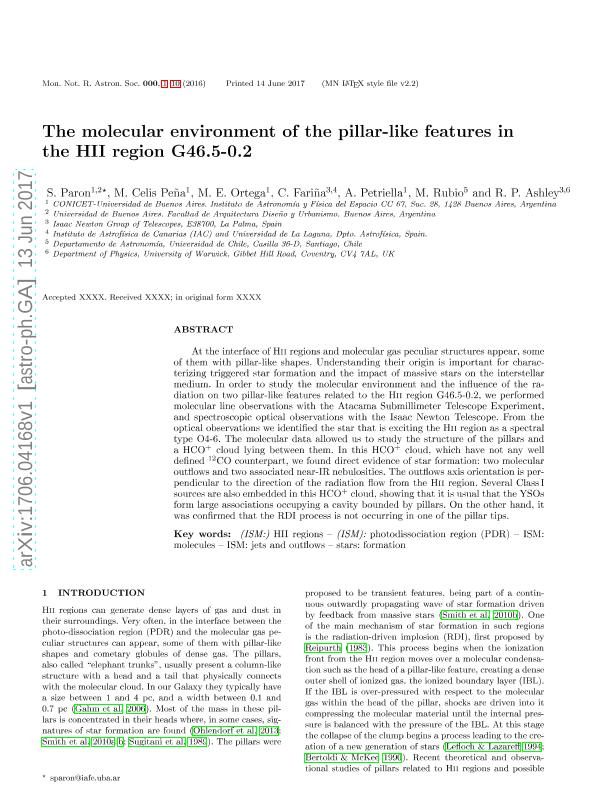Artículo
The molecular environment of the pillar-like features in the H ii region G46.5–0.2
Paron, Sergio Ariel ; Celis Peña, Mariela Fernanda
; Celis Peña, Mariela Fernanda ; Ortega, Martin Eduardo
; Ortega, Martin Eduardo ; Fariña, Cecilia Silvia; Petriella, Alberto
; Fariña, Cecilia Silvia; Petriella, Alberto ; Rubio, M.; Ashley, R. P.
; Rubio, M.; Ashley, R. P.
 ; Celis Peña, Mariela Fernanda
; Celis Peña, Mariela Fernanda ; Ortega, Martin Eduardo
; Ortega, Martin Eduardo ; Fariña, Cecilia Silvia; Petriella, Alberto
; Fariña, Cecilia Silvia; Petriella, Alberto ; Rubio, M.; Ashley, R. P.
; Rubio, M.; Ashley, R. P.
Fecha de publicación:
10/2017
Editorial:
Wiley Blackwell Publishing, Inc
Revista:
Monthly Notices of the Royal Astronomical Society
ISSN:
0035-8711
Idioma:
Inglés
Tipo de recurso:
Artículo publicado
Resumen
At the interface of HII regions and molecular gas, peculiar structuresappear, some of them with pillar-like shapes. Understanding their originis important for characterizing triggered star formation and the impactof massive stars on the interstellar medium. In order to study themolecular environment and influence of radiation on two pillar-likefeatures related to the H ii region G46.5-0.2, we performed molecularline observations with the Atacama Submillimeter Telescope Experimentand spectroscopic optical observations with the Isaac Newton Telescope.From the optical observations, we identified the star that is excitingthe H ii region as spectral type O4-6. The molecular data allowed us tostudy the structure of the pillars and an HCO<sup>+</sup> cloud lyingbetween them. In this HCO<sup>+</sup> cloud, which has no well-defined<sup>12</sup>CO counterpart, we found direct evidence of star formation:two molecular outflows and two associated near-IR nebulosities. Theoutflow axis orientation is perpendicular to the direction of theradiation flow from the HII region. Several Class I sources are alsoembedded in this HCO<sup>+</sup> cloud, showing that it is usual thatyoung stellar objects (YSOs) form large associations occupying a cavitybounded by pillars. On the other hand, it was confirmed that theradiation-driven implosion (RDI) process is not occurring in one of thepillar tips.
Archivos asociados
Licencia
Identificadores
Colecciones
Articulos(IAFE)
Articulos de INST.DE ASTRONOMIA Y FISICA DEL ESPACIO(I)
Articulos de INST.DE ASTRONOMIA Y FISICA DEL ESPACIO(I)
Citación
Paron, Sergio Ariel; Celis Peña, Mariela Fernanda; Ortega, Martin Eduardo; Fariña, Cecilia Silvia; Petriella, Alberto; et al.; The molecular environment of the pillar-like features in the H ii region G46.5–0.2; Wiley Blackwell Publishing, Inc; Monthly Notices of the Royal Astronomical Society; 470; 4; 10-2017; 4662-4670
Compartir
Altmétricas



